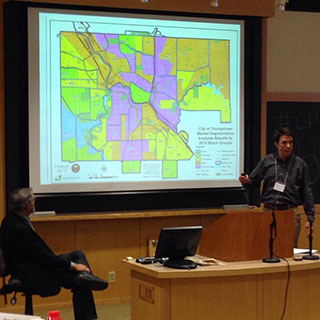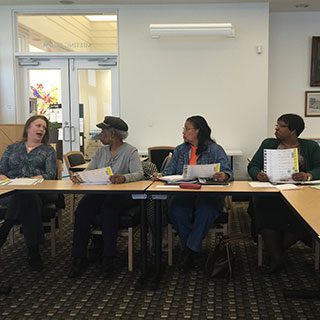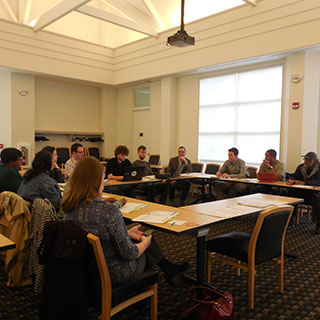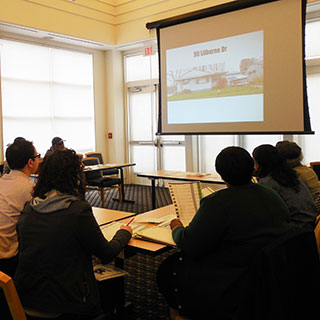Accusations from some city council members that the Youngstown Neighborhood Development Corp. gives preferential treatment to certain areas of the city are wrong, its executive director said.
Ian J. Beniston, YNDC’s head, provided documents Thursday to The Vindicator previously given to council members showing that services — such as Paint Youngstown, which addresses problems such as roof replacement, minor repairs and house painting; and owner-occupied housing rehabilitation — are divided evenly among each of the seven wards.
“Every side of town is treated the same,” he said. “We own real estate and board up houses all over the city.”
The documents for 2012, 2013 and 2014 were provided after Councilwomen Annie Gillam, D-1st, and Janet Tarpley, D-6th, who are black, expressed concerns about past bias by the YNDC.
Council postponed a vote Wednesday on a $102,168-a-year contract with YNDC to supervise and manage a grass-cutting and property-cleanup program.
Gillam said the agency gave “the shaft to certain people all along, and I don’t want to be shafted again.”
Tarpley said, “We can’t act like race isn’t an issue when it’s an issue,” and “YNDC has a history with some of the council people.”
Gillam said Thursday that when the Paint Youngstown program started three years ago, most of the work went to the Idora Neighborhood on the city’s South Side. When YNDC was formed, Idora was the first neighborhood in the city to receive special attention from the agency.
“We didn’t mind some concentration on Idora, but we asked to make it even,” Gillam said. “We had frustration with unfair distribution.”
YNDC made the change to spread the resources evenly in each ward, Gillam said.
“They helped me, but it was after I squawked,” she said. “It is done after we’re yelling about the way they’re doing something.”
But Beniston said Gillam is wrong.
“It’s been shared evenly in each ward since we began,” he said.
Documents provided by Beniston show each of the city’s seven wards had five houses benefit from Paint Youngstown the past two years with the 7th Ward getting a sixth house in 2013.
The distribution wasn’t even in 2012 because of an issue with federal funds, according to YNDC records.
But in 2012, Tarpley’s 6th Ward had the most houses — 13 — benefit from the program; followed by 10 in the 3rd Ward; nine each in the 1st, 5th and 7th wards; and eight each in the 2nd and 4th wards.
Since 2012, YNDC chooses a house in each ward and pays for full rehabilitation of owner-occupied properties, including lead-abatement work, the agency’s records show.
Gillam said getting YNDC to help in her ward has “been a constant hassle,” and “we have to keep our eyes on it every year to push” for fairness.
Beniston, again, said that’s not true.
In support of Beniston’s statements, Councilman Paul Drennen, D-5th, said, “What I’ve seen with YNDC is they’ve been helpful. They do projects all over the city. With the paint program, every council member had an area that benefited from it. Also, a house in every ward was rehabbed. They’ve always been fair with every ward. They’re all over the place.”
Drennen added he doesn’t “like the fact [Gillam and Tarpley] turn it into a race issue. That’s not fair. I can’t believe they brought this up. I don’t know where they get their information.”
Records show Lots of Green, YNDC’s vacant-land reuse program, has done work most of its work in the 1st and 3rd wards. There’s been only one Lots of Green project in the 6th Ward and none in the 4th Ward.
“There has been targeting there” with Lots of Green, Beniston said in explaining the imbalance.
When asked if there are current problems with YNDC, Gillam said, “Right now, I don’t have any outstanding issues with them.”
Beniston said he’s been responsive to calls from all council members.
“If there are specific problems, we respond,” he said. “We can’t know about everything everyone needs. [Gillam and Tarpley] have provided information to us. They live in the wards and represent them. We can’t know about every problem. When they tell us, we respond to their concerns.”
But Gillam said she is concerned her ward won’t be treated fairly by YNDC if council hires the agency to supervise and manage about 20 low-income people, between age 18 and 24, to cut grass, clean debris and illegal dumping sites, do light landscaping and board up vacant structures.
Also, she wants to see YNDC’s plan for the program, and questions why the city is paying for equipment and gas.
“We may be able to get a better deal from someone else or do this through the park department,” Gillam said. “I’m not sure if it can be done by someone else for a lesser amount,” but the city should explore that possibility.
Drennen said private contractors charge about $35 to $50 a lot, and many don’t do a good job, compared with $7 to $10 under this proposal.
Council meets early next week to discuss hiring YNDC for grass cutting and property cleanup. Beniston said he’ll be at the meeting.
To read the full story at Vindy.com, click here.


 ,
,  ,
, 
 ,
,  ,
, 

 ,
,  ,
, 